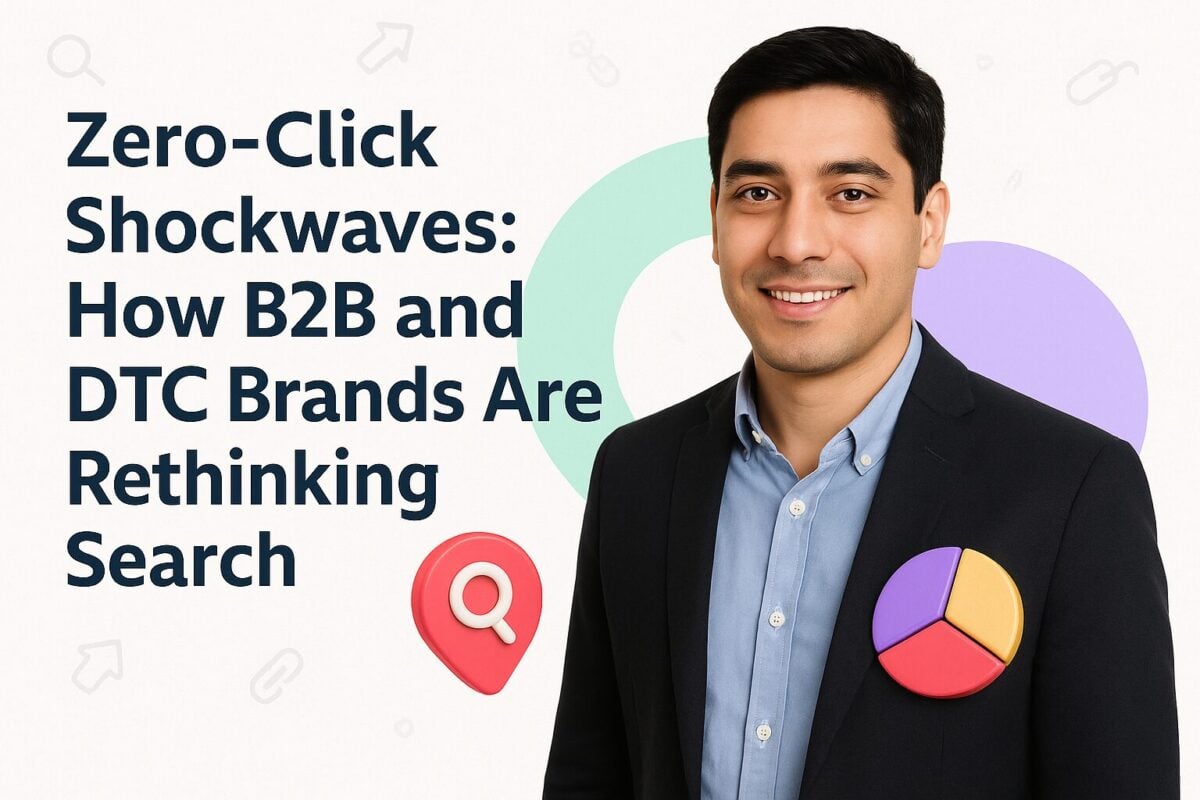Modern marketers are always given the tough choice of determining which is better: inbound or outbound marketing. Should you focus on running ads—both digitally and offline—or invest your resources in the slow-burn process of creating educational content?
With consumers being more educated and aware, marketers need to be more creative in crafting awareness and persuasive campaigns that will generate leads and sales. So how do you choose, and more importantly, is one approach better than the other? Let’s find out.
The Difference Between Enterprise Inbound vs Outbound Marketing - Which is Better?:
- Inbound vs. Outbound Marketing: Differences at a Glance
- Understanding Inbound Marketing
- Key Components of an Effective Inbound Marketing Strategy
- Exploring Outbound Marketing
- Key Components of an Effective Outbound Marketing Strategy
- Comparing Inbound and Outbound Marketing: Which is Better?
- Exploring A Better Solution: Integrated Marketing Strategy
- Integrating Inbound and Outbound Strategies: Companies Who Did It Right
Inbound vs. Outbound Marketing: Differences at a Glance
When it comes to marketing, there are two universal concepts: inbound and outbound marketing. Outbound is the traditional way involving “push” messages, while inbound is a more modern way of using “pull” messages.
Outbound relies primarily on advertising to draw customers in and bring instant results, while inbound depends on content marketing to educate customers and build the brand. Typically, outbound marketing is more aggressive with the aim of converting customers immediately, while inbound marketing uses subtle communication to persuade them to make a purchase over time.
Outbound Marketing | Inbound Marketing |
Pushes messaging to a wider audience using generic messaging | Pulls in interested audiences using targeted messaging |
Makes the brand the center of the messaging | Makes the consumers’ needs the center of the messaging |
Harder to measure customer engagement due to limited attribution tools for physical advertising | Easily track customer engagement using digital marketing software |
Disrupts user experience | Blends seamlessly with user experience |
Passive content like billboards, TV ads, direct mail, etc. | Interactive content such as social media posts, blogs, webinars, etc. |
Usually non-digital content | Mostly informative digital content |
While mostly different from each other, both inbound and outbound marketing are useful for enterprise marketers. Understanding their differences and using their strengths to your advantage will help you harness the potential of both types of marketing.
Understanding Inbound Marketing
Inbound marketing is a customer-centric marketing approach that focuses on attracting and engaging prospects using valuable content and experiences. Unlike outbound marketing, which interrupts audiences with promotional messages, inbound marketing provides helpful information and solutions that address the needs and interests of potential customers. With inbound marketing, you build trust, establish authority, and nurture long-term relationships with your target market.
Benefits of Inbound Marketing for Enterprises
Inbound marketing has several benefits that can help enterprises decide if it’s the right strategy for their company.
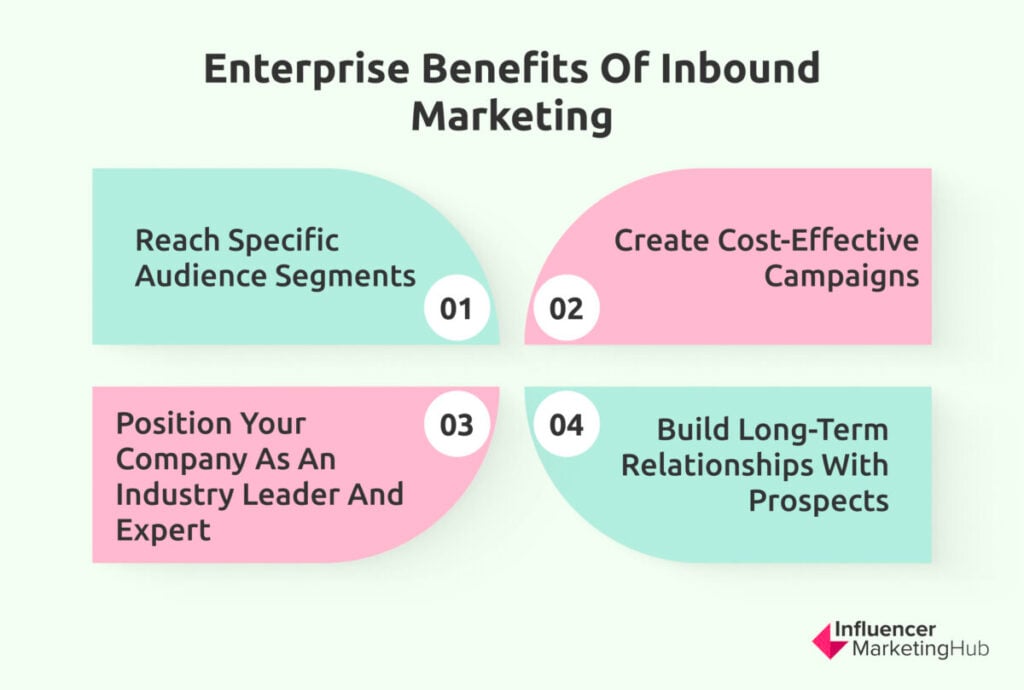
- Reach specific audience segments that are more likely to be interested in your products or services. By tailoring content and strategies to the needs and preferences of these audiences, you can increase your chances of attracting qualified leads
- Create cost-effective campaigns that are more affordable than using traditional advertising channels
- Get the opportunity to position your company as an industry leader and expert by consistently producing high-quality content that educates and informs its audience
- Build long-term and sustainable relationships with prospects through content that provides ongoing value and fosters customer loyalty
Challenges of Inbound Marketing
Despite the benefits, inbound marketing isn’t for everybody. Here are the drawbacks of this strategy:
- Campaigns take a great deal of time and effort because you have to develop and test different content until you find the kind that will resonate with your audience. You also have to be constantly updated with the latest trends so you can stay relevant to your target market
- Requires a holistic strategy that presents the same messaging across different channels so customers gain a consistent brand experience
- Demands continuous maintenance and fresh content since customers’ needs and wants, as well as the channels they engage in, are constantly evolving
Key Components of an Effective Inbound Marketing Strategy
To be successful in inbound marketing, you should consider the following channels and what they can do.
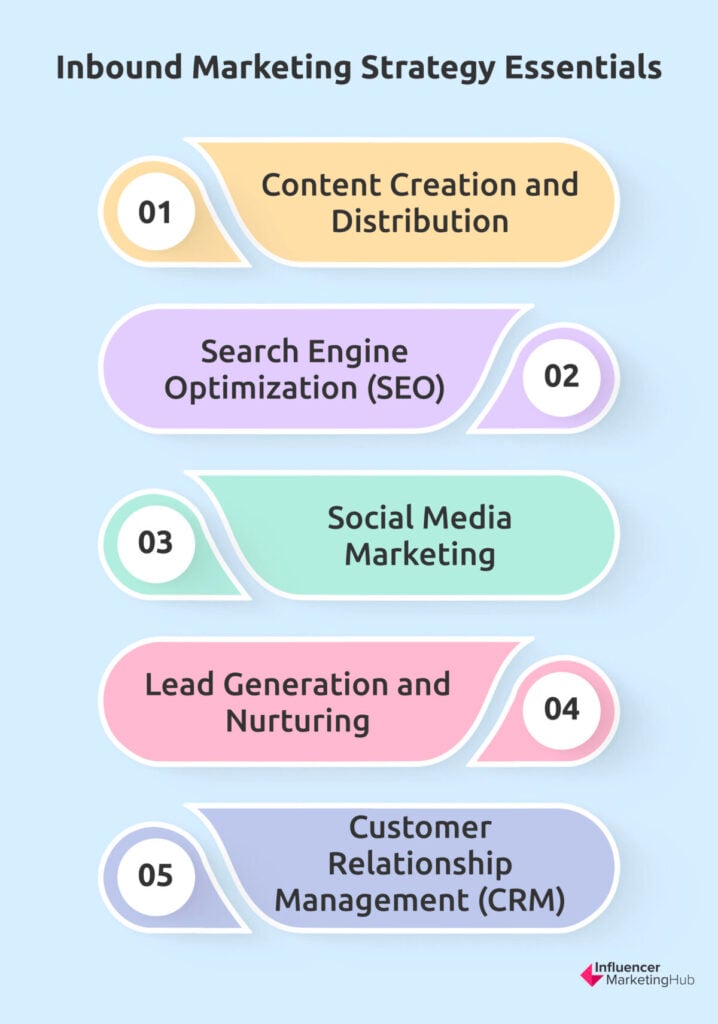
Content Creation and Distribution
Creating valuable and relevant content in various formats, such as blog posts, videos, infographics, and eBooks, is at the core of inbound marketing. This content should address the pain points, challenges, and interests of the target audience, and be distributed through multiple channels to reach and engage prospects.
Search Engine Optimization (SEO)
Optimizing content for search engines helps enterprises increase their organic visibility and attract qualified traffic. Keyword research, on-page optimization, link building, and website structure optimization are crucial for improving search engine rankings and driving targeted traffic.
Social Media Marketing
Leveraging social media platforms allows enterprises to reach a wider audience and engage with prospects and customers. By sharing content, participating in conversations, and building relationships on platforms like Facebook, Twitter, LinkedIn, and Instagram, enterprises can amplify their reach and foster brand advocacy.
Lead Generation and Nurturing
Inbound marketing involves capturing leads by offering valuable resources or incentives, such as whitepapers, webinars, or free trials. Once leads are obtained, enterprises need to nurture them through personalized and targeted communication, delivering relevant content and offers to guide them through the buyer's journey.
Customer Relationship Management (CRM)
Effective inbound marketing strategies integrate a robust CRM system to manage and track customer interactions. CRM enables enterprises to store and analyze customer data, personalize communication, automate marketing workflows, and gain insights for continuous improvement.
Exploring Outbound Marketing
Outbound marketing typically refers to traditional marketing methods like TV ads, billboards, direct mail, and telemarketing. These strategies, which were highly effective in the past, required brands to push messages to a wide audience in the hopes of generating leads or sales. These methods are often interruptive tactics where enterprises actively reach out to prospects without their explicit request or prior interest.
This seemingly “invasive” style of marketing has given outbound marketing a bad rep. In recent years, the oversaturation of ads (including online ads) has led to banner blindness and the rise of ad blockers. But despite the seeming negative consequences, advertising isn’t going anywhere, and both display ad spending and OOH (out-of-home) advertising are on the rise. OOH (think billboards) are projected to reach over $45 billion by 2024, while display ad spending is forecasted to reach $500 billion by 2026.
Benefits of Outbound Marketing for Enterprises
With its growth, it’s clear that outbound marketing has its unique benefits:
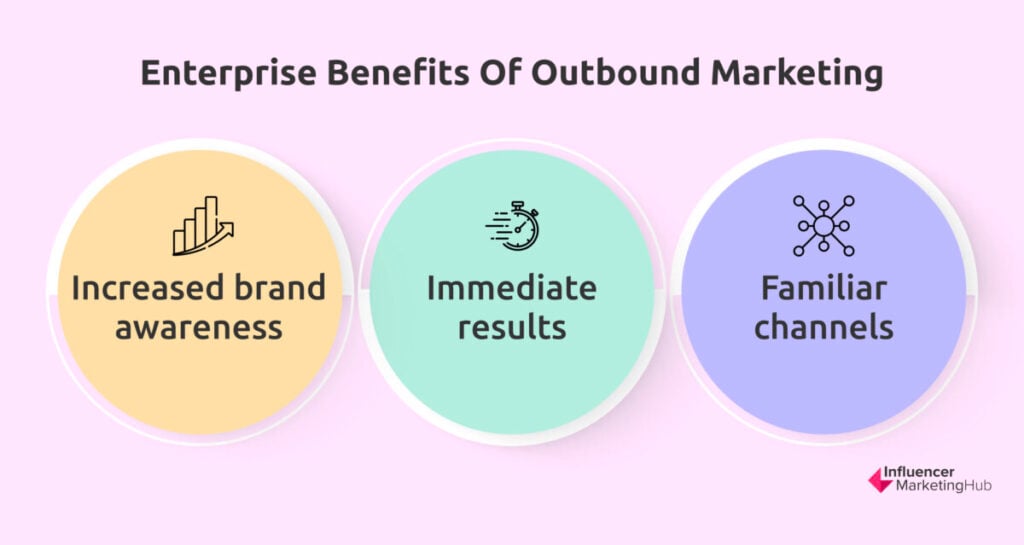
- Increased brand awareness since campaigns are aimed at a wide audience, most of whom have never heard of your products and services
- Immediate results since ads have a clear and urgent message that consumers who need your solution will immediately take action, producing instant leads or sales
- Familiar channels since traditional outbound marketing methods have been used for decades and consumers are familiar with them, making it easier for brands to leverage established channels
Challenges of Outbound Marketing
However, you should also consider the drawbacks of implementing outbound marketing strategies:
- High production and distribution costs that make them less accessible for small or budget-constrained enterprises
- Lower audience targeting since you’re casting a wider net that makes it harder to precisely target specific audience segments, potentially resulting in reaching individuals who have little to no interest in the offering, wasting resources, and potentially irritating recipients
- Consumer resistance as evidenced by the rise of ad-blocking technologies and caller ID used by consumers who want to avoid or ignore outbound marketing messages
Key Components of an Effective Outbound Marketing Strategy
To overcome these challenges, here’s how you can utilize the key components of outbound marketing effectively.
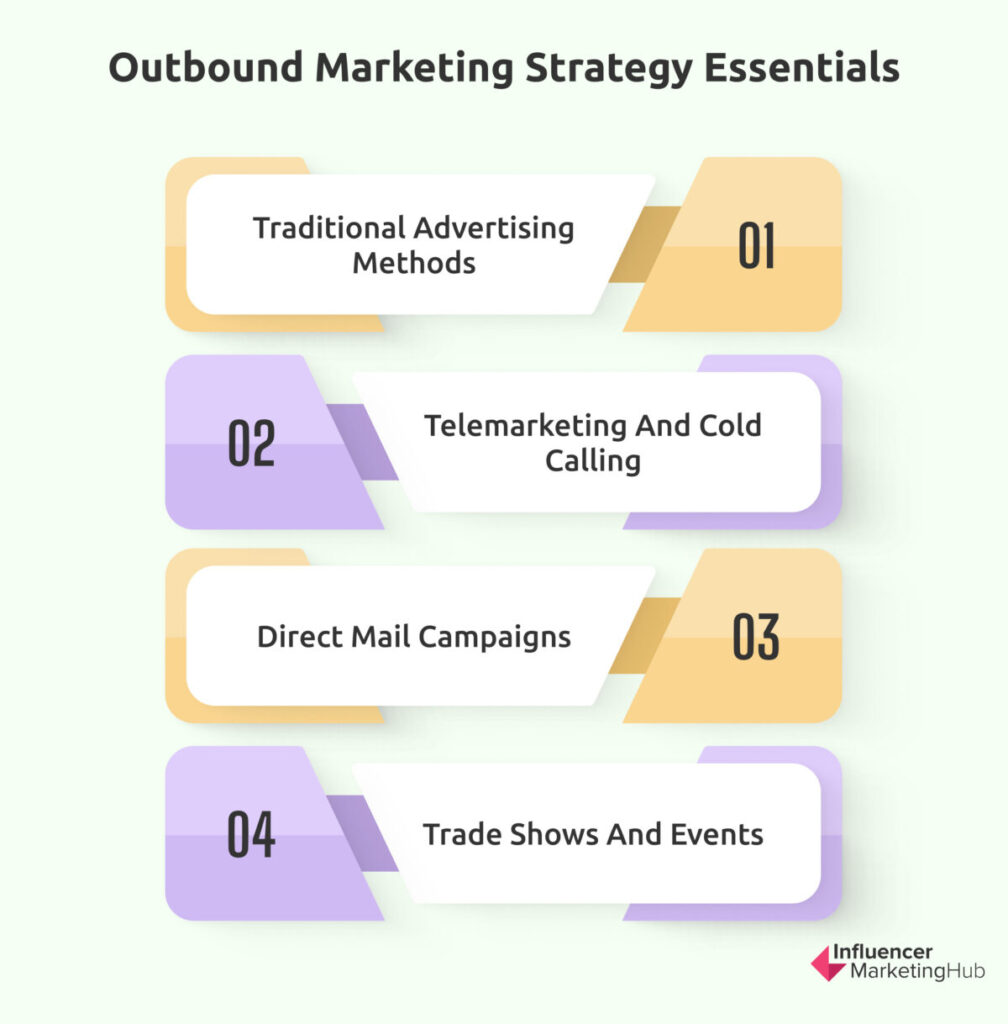
Traditional Advertising Methods (TV, Radio, Print)
Enterprises need to create compelling and attention-grabbing ads that resonate with the target audience. Craft a strong brand message and select appropriate media channels to ensure you reach the right audiences.
Telemarketing and Cold Calling
Enterprises must train their sales representatives to effectively communicate the value proposition and handle objections. Compliance with legal regulations and ethical practices is essential to maintain a positive brand image.
Direct Mail Campaigns
A well-targeted mailing list, personalized content, and compelling calls to action are vital for direct mail success. Enterprises should track responses and follow up with interested recipients to maximize conversion rates.
Trade Shows and Events
Planning and executing engaging booth designs, interactive demonstrations, and informative presentations are key aspects of a successful trade show or event presence. Collecting leads and following up afterward is crucial to capitalize on the connections made.
Comparing Inbound and Outbound Marketing: Which is Better?
Now that you understand the difference between inbound and outbound marketing, you’re probably asking which is better. That depends on several factors:
Cost-effectiveness
Inbound marketing generally offers a more efficient approach compared to outbound marketing. Inbound marketing strategies require lower upfront costs and have the potential for long-term returns.
On the other hand, outbound marketing techniques can be more expensive due to production costs, media placement fees, and distribution expenses. However, if you need immediate results and have the resources to spend for it, then advertising is your go-to tactic.
Targeting and Personalization Capabilities
Inbound marketing excels in targeting and personalization capabilities. Through the use of buyer personas, analytics, and data-driven insights, enterprises can tailor content and marketing efforts to specific audience segments. Inbound strategies allow for delivering personalized messages and experiences that resonate with individual prospects and customers.
In contrast, outbound marketing relies on a broader, less targeted approach, making it challenging to deliver highly personalized content and offers. But if you are after brand awareness from a wider audience base, then advertising is the answer.
Measurement and Tracking of Results
One of the strengths of inbound marketing lies in its ability to measure and track results. With digital tools and analytics, enterprises can gather detailed data on website traffic, conversions, engagement, and customer behavior. This enables them to refine strategies, optimize campaigns, and make data-driven decisions.
Outbound marketing can be more challenging to measure accurately, as it relies on indirect metrics like reach, impressions, or response rates. Tracking return on investment (ROI) and attributing specific outcomes to outbound marketing efforts may be less precise.
Long-term Impact on Brand Building and Customer Relationships
Inbound marketing has a significant long-term impact on brand building and customer relationships. By providing valuable content, addressing customer pain points, and nurturing leads, enterprises can establish themselves as trusted advisors and thought leaders in their industry. The emphasis on building relationships and delivering ongoing value fosters customer loyalty and advocacy.
Outbound marketing, while effective at creating initial brand awareness, may have a more limited impact on long-term customer relationships, as it focuses on immediate lead generation or sales conversion rather than nurturing relationships.
Exploring A Better Solution: Integrated Marketing Strategy
Rather than viewing inbound and outbound marketing as mutually exclusive, enterprises can benefit from integrating both approaches into a cohesive marketing strategy. By combining the strengths of inbound marketing's personalized and value-driven content with outbound marketing's wider reach and immediate impact, enterprises can maximize their marketing efforts.
An integrated strategy may involve leveraging inbound techniques for brand awareness, lead generation, and relationship building while complementing them with targeted outbound tactics for specific promotions or events.
Tips for Successful Execution of Inbound and Outbound Marketing Techniques

- Define clear goals: Clearly articulate the marketing objectives and goals that align with the overall business strategy. This clarity will guide decision-making and ensure that both inbound and outbound marketing efforts work together toward achieving specific outcomes.
- Align messaging and branding: Consistency in messaging and branding is crucial for an integrated approach. Ensure that the core brand values, tone, and voice are maintained across both inbound and outbound marketing efforts, creating a cohesive and recognizable brand identity.
- Coordinate campaigns and channels: Coordinate the timing and messaging of campaigns across various channels to reinforce the marketing message and maximize impact. Integrate inbound and outbound techniques by leveraging social media, email marketing, content distribution, and offline events to support and amplify each other.
- Track and analyze results: Implement robust tracking and analytics systems to measure the performance and impact of both inbound and outbound marketing efforts. Regularly analyze the data to gain insights, identify areas for improvement, and make data-driven adjustments to optimize marketing strategies.
- Continuously adapt and evolve: The marketing landscape is constantly evolving, and consumer behavior and preferences change over time. Stay updated on industry trends, technology advancements, and shifts in audience behavior. Be willing to adapt and evolve the marketing strategy accordingly to stay ahead of the competition and meet the ever-changing needs of the target audience.
By considering these tips and strategically integrating inbound and outbound marketing techniques, enterprises can create a comprehensive and effective marketing approach that maximizes their reach, engages their audience, and drives business growth.
Integrating Inbound and Outbound Strategies: Companies Who Did It Right
Using an integrated marketing strategy isn’t new. Companies have been using this blended strategy for decades, and the following examples will attest to the success of this blended approach.
Coca-Cola’s “Share a Coke” Campaign
Coca-Cola successfully integrated inbound and outbound strategies in its "Share a Coke" campaign. The outbound aspect involved personalized bottles with individual names, encouraging customers to find and share their unique bottles on social media. This generated buzz and encouraged user-generated content, combining outbound promotion with inbound social media engagement and word-of-mouth marketing.
Salesforce Marketing Strategy
Salesforce, a cloud-based CRM platform, successfully implemented inbound and outbound marketing strategies to boost sales and retain loyal customers.
Through their content marketing efforts, which include blog posts, podcasts, and webinars, they provide valuable insights and thought leadership to their audience. By nurturing leads with personalized email campaigns and providing exceptional customer experiences, Salesforce has become a trusted and influential brand in the enterprise software industry.
But the company didn’t stop there. Salesforce is also known for its outbound marketing efforts. They have successfully utilized telemarketing to generate leads. By having a well-trained sales team and focusing on personalized communication, they have achieved significant success in acquiring new customers. They also frequently organize live events and work with the press and industry experts to gather third-party validation and positive coverage.
These case studies demonstrate the potential synergies of integrating inbound and outbound marketing strategies. By leveraging the strengths of each approach, enterprises can maximize their reach, engage audiences through personalized experiences, and create memorable brand interactions that lead to long-term customer relationships and business growth.
Final Thoughts
Effective marketing doesn’t have to be one-sided. You can combine inbound and outbound marketing strategies to maximize your efforts and generate the most marketing impact. By creating clear goals and developing a deep understanding of your target audience, you can successfully launch an integrated marketing campaign.
In the dynamic world of marketing, a flexible and adaptive approach that combines the best of inbound and outbound marketing is key to staying relevant, engaging customers, and driving business growth in today's competitive landscape.

